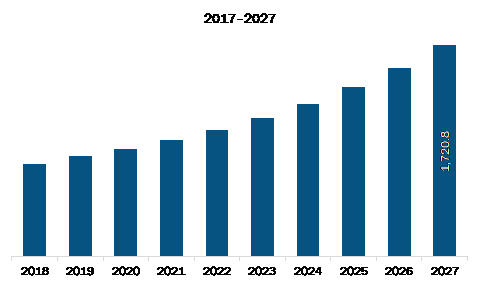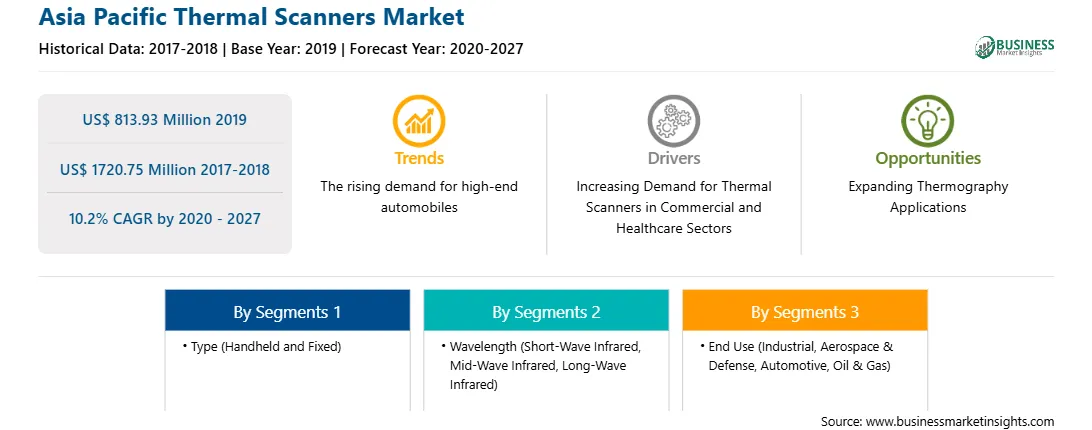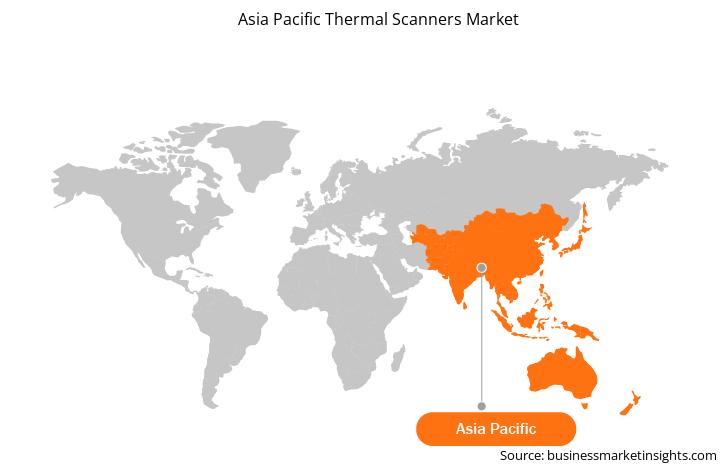Thermal scanners detect body heat radiation-usually from the forehead-then estimate core body temperature. These cameras are a potent tool often used by firefighters to track smouldering embers and police to search for suspects who are out of sight. COVID-19 outbreak has increased demand from healthcare facilities for the thermal scanners. The device helps healthcare professionals monitor the temperature of the patient's body and take necessary action based on scanner results. The airline industry has also increased demand for thermal scanners, where air passengers are screened for any symptoms of the virus. Those factors will affect market growth over the forecast period.

Strategic insights for the Asia Pacific Thermal Scanners provides data-driven analysis of the industry landscape, including current trends, key players, and regional nuances. These insights offer actionable recommendations, enabling readers to differentiate themselves from competitors by identifying untapped segments or developing unique value propositions. Leveraging data analytics, these insights help industry players anticipate the market shifts, whether investors, manufacturers, or other stakeholders. A future-oriented perspective is essential, helping stakeholders anticipate market shifts and position themselves for long-term success in this dynamic region. Ultimately, effective strategic insights empower readers to make informed decisions that drive profitability and achieve their business objectives within the market.

| Report Attribute | Details |
|---|---|
| Market size in 2019 | US$ 813.93 Million |
| Market Size by 2027 | US$ 1720.75 Million |
| Global CAGR (2020 - 2027) | 10.2% |
| Historical Data | 2017-2018 |
| Forecast period | 2020-2027 |
| Segments Covered |
By Type
|
| Regions and Countries Covered | Asia-Pacific
|
| Market leaders and key company profiles |
The geographic scope of the Asia Pacific Thermal Scanners refers to the specific areas in which a business operates and competes. Understanding local distinctions, such as diverse consumer preferences (e.g., demand for specific plug types or battery backup durations), varying economic conditions, and regulatory environments, is crucial for tailoring strategies to specific markets. Businesses can expand their reach by identifying underserved areas or adapting their offerings to meet local demands. A clear market focus allows for more effective resource allocation, targeted marketing campaigns, and better positioning against local competitors, ultimately driving growth in those targeted areas.

The adoption of thermal scanners has been increasing in the automotive sector. Earlier, the use of the technology was limited to high-end automotive models due to the high cost of these devices. The risk-associated factors such as glare, darkness, and animal crossing, especially during night, can be reduced with the help of thermal cameras, thereby increasing overall road safety by keeping drivers alarmed while driving. These cameras can be easily integrated with existing infotainment systems. The thermal imaging technology is also expected to gain momentum in road safety and railroad applications in the coming years. Further, various automotive companies follow organic and inorganic growth strategies to establish themselves in the competitive market. Thus, with the increasing adoption of thermal scanners in the automotive industry, the market is likely to grow at a robust pace during the forecast period.
APAC region is characterized by the presence of a large number of developing countries, positive economic outlook, high industrial presence, and huge population. The high growth rate of urbanization and industrialization in developing countries of Asia Pacific region is anticipated to offer ample growth opportunities to the market players operating in the APAC thermal scanners market. However, due to global pandemic situation, the manufacturing industries has witnessed temporary disruptions in their business processes which has resulted into huge loss. Nevertheless, during lockdown period, the adoption of thermal scanners was limited, however as industry and businesses are reopened and economy started reviving the thermal scanner market players has witness demand from electronics, automotive, textile, and healthcare sectors.
In terms of type, the fixed segment accounted for the largest share of the APAC thermal scanners market in 2019. In terms of wavelength, the mid-wave infrared segment held a larger market share of the APAC thermal scanners market in 2019. Further, the industrial segment held a larger share of the market based on end use in 2019.
A few major primary and secondary sources referred to for preparing this report on the thermal scanners market in APAC are company websites, annual reports, financial reports, national government documents, and statistical database, among others. Major companies listed in the report are FLIR Systems, Inc., AMETEK Inc., Robert Bosch GmbH, 3M company, and Fluke Corporation and among others.
The List of Companies- Asia-Pacific Thermal Scanners Market
The Asia Pacific Thermal Scanners Market is valued at US$ 813.93 Million in 2019, it is projected to reach US$ 1720.75 Million by 2027.
As per our report Asia Pacific Thermal Scanners Market, the market size is valued at US$ 813.93 Million in 2019, projecting it to reach US$ 1720.75 Million by 2027. This translates to a CAGR of approximately 10.2% during the forecast period.
The Asia Pacific Thermal Scanners Market report typically cover these key segments-
The historic period, base year, and forecast period can vary slightly depending on the specific market research report. However, for the Asia Pacific Thermal Scanners Market report:
The Asia Pacific Thermal Scanners Market is populated by several key players, each contributing to its growth and innovation. Some of the major players include:
The Asia Pacific Thermal Scanners Market report is valuable for diverse stakeholders, including:
Essentially, anyone involved in or considering involvement in the Asia Pacific Thermal Scanners Market value chain can benefit from the information contained in a comprehensive market report.